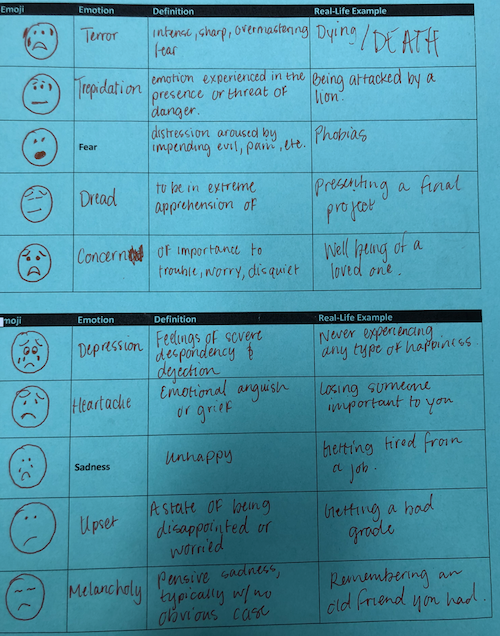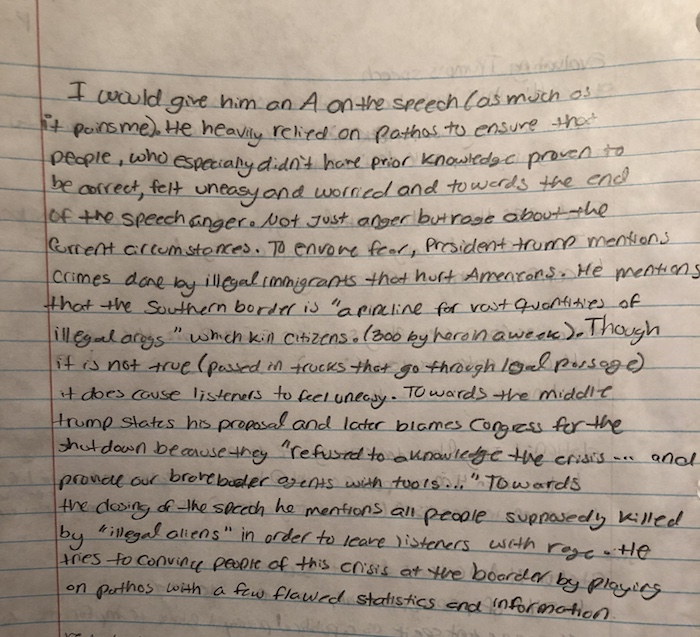My guiding principle when bringing controversy into the classroom is this: ground the conversation in a text.
With this approach, my Chicago Public Schools writing students focus on the ideas. The conversation doesn’t veer off into the abyss of hypotheticals, exaggerations, and explosive personal experiences that only reaffirm what we already believe.
As difficult as it was to listen to Trump’s Oval Office Address about the border wall, I listened to the real-world example of rhetorical principles my high-school junior and senior students study at Hancock College Prep on Chicago’s Southwest side.
Other times with other controversies, we spend time acknowledging our emotional reactions at the beginning of class. But today, we hit the floor running. (Plus I only had one preparation period at the beginning of the day—at least that, thankfully—to create slides, find audio, make copies, generate posters, and figure out my talking points.)
Our 90-minute classes allow for focused deep dives into complex issues. And then we’re done. Students walk out and move on (and so do I).
I asked my students to walk around the room, to examine posters of USA Today’s “9 facts you should know about the border before Trump addresses the nation.” They documented if each fact reaffirmed, challenged, or gave them new background knowledge. Many students expressed surprise when they learned many undocumented immigrants do not cross the border illegally. Instead, they overstay their visas.
Then, we listened to —we didn’t watch— Trump’s speech. I wanted them to focus on the text, which they had a hard copy of, not on the optics.
As they listened, they were to circle any information they needed clarification about. Before the audio started, Jennifer, who makes me laugh a lot, immediately started circling the entire sheet. We busted out laughing. (I had to share that on Twitter.)
These teens crack me up every…day! pic.twitter.com/n9kjImKigd
— Ray Salazar (@WhiteRhinoRay) January 9, 2019
After I saw students cringe during the 10-minute speech, they divided the text into three sections: beginning, middle, and end (a classic strategy for text analysis). Then each group of students started the analysis with a different part of the text. They articulated what Trump argued in each section. They also used a continuum that we developed of the six basic emotions to infer Trump’s emotional appeals.


What did they find?
Trump focused on evoking anxiety, heartache, horror, distress, exasperation. And my students disappointedly began to conclude that Trump achieved his rhetorical purpose:
To convince Americans that there is a crisis at the border and funding for a wall should be approved so the government shutdown can end.
“He makes this sound so simple,” Jose said. “Something that can be solved in one forty-five minute meeting.”
“He wants to make immigrants sound evil,” Ximena’s table told me.
Disheartened, they recognized that Trump succeeded.
Remember, I didn’t want them to express if they agreed or disagreed with Trump, if they liked or disliked him. Their challenge focused on analyzing and evaluating if the speech fulfilled its intended purpose.
Then, they used our class’s grading scale. Things got glum. Between 82% and 92% of my classes gave Trump’s speech —not Trump himself— an A or a B. The speech met or exceeded its purpose.
Interestingly, this judgment came from students who are over 90% Latino or first-generation and highly progressive. Many are low-income and some are undocumented.
One student recognized, “It’s A worthy but at times it sounds manipulative.” Karen said, “I would give him and A (as much as it pains me).”


Ruben gave him an A because he recognized that people who had not read USA Today’s “9 facts” piece would easily be convinced.
That’s the complex part when we study rhetoric; ultimately, we must decide on the effectiveness of the text—not on whether or not we like the speaker or the policy.
A few students gave him a C.
Evelyn explained, “Trump claims that ‘children are used a human pawns,’ but Guatemalan children are losing their lives under his watch.” Another student gave Trump a D because “he showed his inability to be flexible and compromise. The end was the worst,” the student continued, “as he tries to instill fear to evoke change through narrow examples to only show one perception.”
Evaluating Pelosi’s and Schumer’s Responses
My other guiding principle is this: if the controversy proves to be emotionally devastating, students must experience some level of catharsis.
So we listened to Nancy Pelosi’s and Chuck Schumer’s responses. But before they graded these texts, students read NPR’s fact check of Trump’s six claims.
While many students initially gave Pelosi high grades, they realized—after reading the fact check—she missed many opportunities to debunk Trump’s speech.
“Pelosi’s speech was predictable,” Evelyn said.
Ruben said, “She didn’t take the time to prepare and attack his arguments directly.” He lowered her grade from a B to a C.
One student raised her grade from a B to an A. I couldn’t figure out why when he tried to explain it. He didn’t really care to. So we just giggled about it and moved on
Schumer, most students agreed, provided a more targeted response to Trump’s claims. Ninety-three percent of the students gave him As or Bs.
Ocasio-Cortez’s Response
How can we ignore Alexandria Ocasio-Cortez’s rhetoric in these times?
We finished off the class by listening to her interview on MSNBC. To be fair, I only played the first two minutes of her response and muted the host so as not to sway students. Again, we focused on the text.
Well, Ocasio-Cortez earned only As and Bs—not bad for a freshman congressperson. And, as you can see, my students take grading seriously.


Was This a Bad Lesson to Teach?
Should I have spent our class allowing students to bash Trump’s policies and leadership and values? No, that wouldn’t have gotten my students anywhere. They know Trump based his speech on self-centered, xenophobic values.
What they learned in class was how a selfish and incompetent leader makes people believe he knows what’s best. Quite frankly, they learned to see through the BS.
This exercise also made me realize that Trump’s audience with this border wall speech was not the entire country. He talked to his racist supporters. Trump knows how to solidify their support.
In a recent Atlantic article “The Real Roots of American Rage,” Charles Duhigg explains how “Anger is one of the densest forms of communication. It conveys more information, more quickly, than almost any other type of emotion.”
And I didn’t want my students to leave angry. I wanted them to leave empowered and more knowledgable about how the world really works.
Students turned in their drafts and walked out the door, returning to their teenaged lives on social media and whatever else young people do these days.
And they were glad that they didn’t have any English homework.
***
For more about Ray Salazar, check him out at The White Rhino Blog’s Facebook page, or on Twitter @whiterhinoray.


